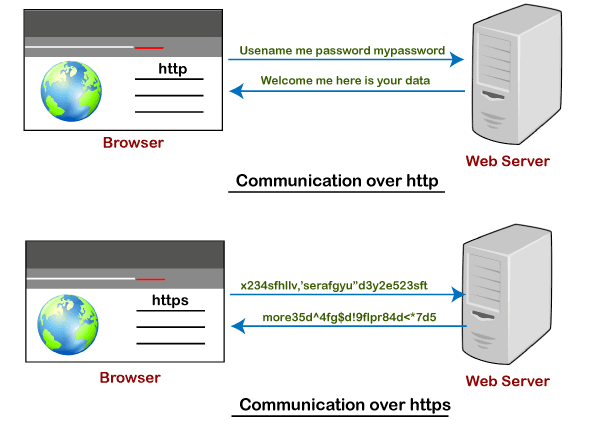SSL vs HTTPS | Difference between SSL and HTTPSIn today's internet world, security is most important so that any unauthorized person or third party cannot temper the data. Security is a must for some websites where we need to enter personal details or perform any money transactions. Hence, if you are looking to make your website secure, you must need to be aware of HTTPS and SSL. Both HTTPS and SSL are used to make the communication or transaction more secure over the internet. Both technologies prevent the data from being read by the man in the middle while sending or receiving the data on the internet. 
The SSL and HTTPS are mostly used together, so are both similar to each other? The answer is no. HTTPS is the secured version of HTTP protocol that is used by the browser for communication. It uses SSL/TLS for delivering the encrypted data. On the other hand, SSL is an encryption protocol that is used to encrypt data. In this topic, we are going to explain SSL and HTTPS protocols and what are the differences between both of them. But before proceeding, let's first understand about basics of these two, i.e., HTTP. What is HTTP?
This request is processed by the server, and it returns the response to the client, which is known as an HTTP response. The http request and response are in the form of simple text; anyone who is monitoring the session can read the information that is being transferred. Hence it can be a threat as the information can be tempered by man in the middle. To remove this threat, HTTPS was introduced, which is the secured version of HTTP. What is HTTPS?HTTPS Stands for Hypertext Transfer Protocol Secure, which is the secure version of the HTTP protocol. It encrypts the data that is retrieved by HTTP protocol and also ensures that data that is being transferred between computers and servers cannot be read by any third person. HTTPS does this encryption with the help of encryption algorithms. When HTTP is combined with an encryption protocol such as SSL/TLS, it is known as HTTPS. The use of HTTPS is important to enhance the security of data transfer and mostly in the case of transferring sensitive information such as bank details. Nowadays, most of the websites use HTTPs protocol because it enhances the trust of users that their data is safe with the websites, and also prefer by the search engines. Whenever a user goes online, he must have and need some degree of privacy, whether it is ISP, Government or, any other organization. So, even if there is no personal or crucial information is being transmitted, HTTPS is one way to ensure that the user's data remains as private as possible. 
Advantages of HTTPS
What is SSL?SSL stands for Secure Sockets Layer, which is an encryption-based internet security protocol created by Netscape in the year 1995. It encrypts the data and is used with HTTP protocol. The combination of SSL with HTTP makes the website secure, and HTTP is changed to HTTPS. This protocol is used to ensure data security over the internet. It uses public-key encryption for securing the data. When a client/computer tries to communicate with the website that is using SSL, the browser asks the website to give its identification. To respond to this, the web server sends a copy of its SSL certificate to the computer. After checking this certificate, the encrypted communication between the browser and web server starts. But what is an SSL certificate? Let's understand it: SSL Certificate
The public and private keys used with SSL certificates are the long Strings of characters, and these keys are used for encryption and decryption of the data. Data that is encrypted with the public key can only be decrypted with the associated private key. Moreover, a private key can be used by its owner to sign other digital documents, and this signature can be verified using the public key. 
How does SSL/ TLS Work?Th working of SSL is explained in below points:
Note: You can check whether a site is using an SSL certificate by seeing the URL. If it is showing HTTPS with a domain name, then it is secured with SSL or TLS, else not.Why SSL/TLS is mandatory?The SSL/TLS is mandatory if we are transferring some sensitive information such as banking details, user-name & password, or any payment-related information. Below are the cases in which SSL/TLS is mandatory:
How is HTTPS different from SSL?As from the above discussion about SSL and HTTPS, we can say, HTTPS and SSL are different technologies that are related to each other. HTTPS is the combination of HTTP and SSL/TSL and is used to encrypt the communication between server and browser. SSL is a cryptographic protocol that ensures secure and encrypted communication over the internet. TLS/SSL can be also be utilized to secure other app-specific protocols apart from HTTPS. These protocols are SMTP, FTP, XMPP, and NNTP. Comparison chart between SSL and HTTPS
ConclusionHTTPS and SSL are fundamentally connected to each other. HTTPS is "HTTP over SSL." When we configure an SSL certificate with the website, it transmits data using HTTPS. Mostly both technologies are used together. (Although instead of SSL, TLS, the successor of SSL, is currently being used).
Next TopicDifference Between
|
 For Videos Join Our Youtube Channel: Join Now
For Videos Join Our Youtube Channel: Join Now
Feedback
- Send your Feedback to [email protected]
Help Others, Please Share










